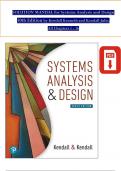Exam (elaborations)
SOLUTION MANUAL For Systems Analysis and Design, 10th Edition by Kendall Kenneth and Kendall Julie, Verified Chapters 1 - 16, Complete Newest Version
SOLUTION MANUAL For Systems Analysis and Design, 10th Edition by Kendall Kenneth and Kendall Julie, Verified Chapters 1 - 16, Complete Newest Version SOLUTION MANUAL For Systems Analysis and Design, 10th Edition by Kendall Kenneth and Kendall Julie, Verified Chapters 1 - 16, Complete Newest Version...
[Show more]



